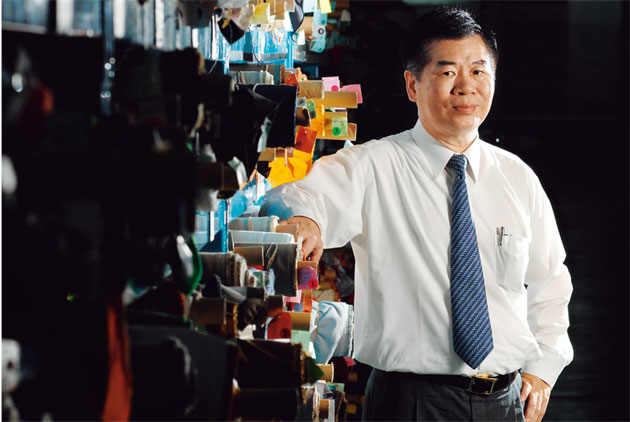Everest Textile Co.
Riding the Green Wave to New Markets

Source:CW
Five years ago, Everest devoted itself to the production of green textiles and expansion through R&D and marketing. Its next move is to amp up marketing internationally.
Views
Riding the Green Wave to New Markets
By Hsiao-Wen WangFrom CommonWealth Magazine (vol. 404 )
Like a leaf in a maelstrom, Everest Textile Co. has emerged from the textile industry price war with a winning chip in green textile production.
Osaka, Japan, 2003 – Roger Yeh, president of Far Eastern Group subsidiary Everest walked into the office of his long-time partner, Teijin Fiber, for their usual chat over tea, and was shown their new fabrics made from reclaimed pieces usually discarded during the production process. With that year's NT$800 million in losses and surplus inventory clearance plans weighing heavily on his shoulders, he imported the process to Taiwan with the thought that he had nothing to lose by trying. No one knew that this would be the turning point, when Everest would enter the green market for good.
Tainan County, Taiwan, 2008 – the Everest factory roars with the sound of machines weaving plain white cloth. It's hard to imagine that these countless threads have been made from reclaimed plastic bottles, or from waste threads and cloth scraps left over from the spinning process. "Everest has everything from bottle-to-fiber to fiber-to-fiber. We have built our green enterprise on the idea that ‘waste equals food.'" Now in his sixties, Yeh is able to recall, in English, the innovative production ideology presented in William McDonough's book Cradle to Cradle: Remaking the Way We Make Things.
Riding the Global Green Wave
Within five years, Everest has successfully turned its losses into profit, and revenues have gradually climbed from NT$4.95 billion to last year's NT$5.32 billion. Surprisingly, green textiles made from reclaimed polymers, corn fiber fabric and natural organic cotton now generated 14 percent, or over NT$700 million, of total company revenues last year.
Everest has become Taiwan's pioneer in green textile production. Not only has it recently become a Swiss bluesign member for its production process, Yeh has even traveled to Munich to speak on his experience with eco design and production at Volvo's Design Forum. Going green has become Everest's long-term strategy. As an upstream fabric supplier for major sporting equipment brands including Nike, Adidas and Patagonia, Everest has devoted itself wholeheartedly to joining the worldwide green trend.
"Nike has said that it will be using only recycled polymers and other green fabrics by 2012, 10 percent of fabrics purchased by Marks & Spencer are already recycled, and Patagonia is currently implementing its own Common Threads Garment Recycling Program," details Yeh. Everest employees know that no one understands their clients' every move better than their president of 20 years.
Roots in R&D, Branching Out with Marketing
In addition to having a good grasp on international trends, Everest also thrives on its commitment to R&D and green marketing.
Just outside the window, the hot Tainan sun is beating down. Inside the Everest Technology Research Center, all is quiet. One person is looking into a microscope while another is testing the water repellency of an experimental fabric. On the shelf in the employee rec room, there is a copy of the Eco Textile News, launched just the year before. "Developing fabric that is highly water-pressure resistant, water resistant, as well as breathable, is not actually that difficult," Center researcher Dr. Hsin-Huang Lin (a chemistry Ph.D.) explains as he keeps his eye on a dark blue fabric membrane that is being tested.
The dedicated Dr. Lin is a perfect example of Everest's own dedication to R&D. Everest invests over NT$200 million in R&D each year, and more than 20 of its 61-member staff hold graduate degrees.
"We at Everest believe that R&D is the propellant for green textile development and the engine powering company profits," said Everest Technology Research Center manager Teddy Huang. However, the future of green technology at Everest depends not only on deeply rooted R&D efforts, but also on branching out with marketing efforts.
Yeh sees Interface, Inc. – a U.S. carpet company unrivaled for its environmental consciousness – as the model for Everest development, and is a devotee of Interface-founder Ray C. Anderson's book Mid-Course Correction: Toward a Sustainable Enterprise – The Interface Model. Like Interface, the next step for Everest is not only green products, but building a green brand-image.
In a recent meeting, the general manager of Levi Strauss in China was deeply moved by Yeh's gift of the documentary "Waste Equals Food" and the book Cradle to Cradle, and suggested that Yeh make a promotional video of Everest's green production methodology.
This fall, Yeh will be using just such a video to promote Everest at Levi Strauss & Co.'s headquarters in San Francisco.
"Our clients need to feel that buying from us will prove they are a green enterprise," says Yeh, highly cognizant that while competitors may try to take a piece of the new market for green products, they cannot replicate Everest's market image.
For Everest, the green road underfoot is growing ever wider and longer.
Translated from the Chinese by Ellen Wieman
Chinese Version: 跟上綠潮流,織出新市場






